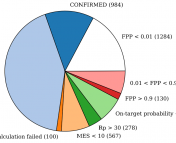Title: How open science helps researchers succeed
Authors: Erin C. McKiernan, Philip E. Bourne, C. Titus Brown, Stuart Buck, Amye Kenall, Jennifer Lin, Damon McDougall, Brian A. Nosek, Karthik Ram, Courtney K. Soderberg, Jeffrey R. Spies, Kaitlin Thaney, Andrew Updegrove, Kara H. Woo, Tal Yarkoni
First Author’s Institution: National Autonomous University of Mexico, Mexico
Status: Published in eLife, open access
What is this ‘open’ thing anyway?
Open scholarly practices are on the rise. An everyday example of this is the now widespread use of the arxiv.org preprint server. Researchers upload their prepared manuscripts (either before, during, or after submission, depending on the journal’s policies and the author’s preferences) which can then be downloaded and easily distributed (via the link) for free by everyone. This is a great start, but open research practices still have a long way to go:
Only 19% of Icarus papers are put on astro-ph, despite this being allowed by journal. Planetary science behind the curve? #dotastro
— Matthew Kenworthy (@mattkenworthy) June 21, 2016
And there can be much more to it than just uploading your mental acrobatics to a public server: openly sharing your data, methods, codes, scripts, figures, opening your proposals or even openly write your papers are methods of open practices which receive mixed kinds of reception from the communities. We here use open as a synonym for publicly accessible (over the internet) without any paywall.
This post follows the recent paper from McKiernan et al. (2016), published in the peer-reviewed open access journal eLife, whose authors presented and discussed evidence from a multitude of recent studies about how open scholarly practices not only benefit the community, but the openly-working researchers themselves.
Why you should do it
First of all, attentively inspect Figure 1 (hint: watch out for the 2nd row, your favorite subject).
![Figure 1. Open access publications are cited more often. In this chart McKiernan et al. show the relative citation rate (average citations of open access articles divided by average citations of non-open access articles) for various fields, based on evaluations of several statistical studies. [Figure 1 of the paper]](https://astrobites.org/wp-content/uploads/2016/12/Screenshot-2016-12-02-07.20.46.png)
Figure 1. Open access publications are cited more often. In this chart McKiernan et al. show the relative citation rate (average citations of open access articles divided by average citations of non-open access articles) for various fields, based on evaluations of several statistical studies. [Figure 1 of the paper]
Open accessible physics/astronomy papers receive up to 5 times (~3 times on average) more citations than non-open access publications! At the same time they receive more media attention (which probably correlates with their higher citation rates). In addition to that, McKiernan and co-workers discuss in full length the community’s gains from open scholarly practices. Among many, researchers going open can benefit from clearer documentation of their own work for later reuse (you don’t want other people to see your mess, so you put more effort into it, from which you *will* eventually benefit yourself).
Clearer documentation, open data and methods help the community in general by easier access to resources. It eases reproducibility of studies and leads to follow-up work which can better build upon work which was already done (gaining more citations…). This, in turn, helps you, as author of open work, to easier find new projects and collaborators, because it is easy for peers to understand what you were actually doing and how your research is embedded into the community. Additionally, you can distribute your own papers to whomever you like (unlike with some/many subscription journals, where you are legally not allowed to send a copy of your paper to your own mum). Finally, subscription journals create a dual-class society by charging high fees: institutions (and thus people) who can and those who cannot afford the subscription fee. As a side note, these circumstances raised public awareness due to websites like sci-hub and personal incidents of people standing up for open knowledge.
Let’s discuss a few perceived drawbacks of open practices. First of all, people in different fields fear about lower prestige and impact factors of open access journals (abbreviated as OA, from now on). Even if you would allow the journal impact factor as an essential metric (it is a heavily biased, flawed number and should not be used to evaluate research at all), impact factors of OA journals are steadily rising. And, remembering Figure 1, this criticism should be gone quite soon. Secondly, peer review: it was shown often enough that transparent practices (e.g., openly accessible author-referee conversation logs) increase the quality of peer review. These are offered by OA journals more often than by non-OA journals. Thirdly, high costs: this is halfway true and we will come to that later.
How you can do it (right now)
As McKiernan and co-workers highlight, adopting open science practices do not need long-term commitment or intensive effort. In fact, it is strikingly easy and fast to engage in open practices. They suggest 5 steps, which require minimal effort, help the overall case and benefit the researcher (you) directly:
![Figure 2. What you can directly do to engage in open scholarly practices with minimal effort. [Box 1 in the paper]](https://astrobites.org/wp-content/uploads/2016/12/Screenshot-2016-12-02-10.25.53.png)
Figure 2. What you can directly do to engage in open scholarly practices with minimal effort. [Box 1 in the paper]
Let’s be more astronomy-specific now. Many of the most well-known astronomy journals have standard subscription models. This means, if you submit your paper with them as usual, it will be behind a paywall (and only subscribers can download it). Most of them offer a so-called “gold open access” option nowadays, which charges you (or better, your institution) a fee for publishing and then the paper is open access. Unfortunately this is still a high-enough hurdle for many (even though, check Figure 3, things are moving). In any case though, the journals allow the upload to preprint servers such as arxiv (which they call “green open access” sometimes). However, a word of caution: be aware that sometimes there are specific regulations, for instance, having to upload your preprint before submission. So go and check beforehand.
![Figure 3. An ever increasing number of institutions embrace open research practices as part of the academic culture. Examples of such policies can be rules about having to openly share data or publications. [Figure 2 of the paper]](https://astrobites.org/wp-content/uploads/2016/12/Screenshot-2016-12-02-08.05.07.png)
Figure 3. An ever increasing number of institutions embrace open research practices as part of the academic culture. Examples of such policies can be rules about having to openly share data or publications. [Figure 2 of the paper]
Astrobites supports open science
In this article we mostly highlighted the use of publishing openly. However:
Openness can be […] defined by a continuum of practices, starting perhaps at the most basic level with openly self-archiving postprints and reaching perhaps the highest level with openly sharing grant proposals, research protocols, and data in real time. Fully open research is a long term goal to strive towards, not a switch we should expect to flip overnight. — McKiernan et al. (2016)
Therefore, in order to support the gaining momentum of open scholarly practices in general, Astrobites.org will, from now on, add an additional metric to each bite’s header (where it says “Status”). Each paper will be categorized as either open access or closed access. We distinguish only two categories, where open access includes every article of which a publicly accessible version of the manuscript (be it from the journal itself, a preprint server or a university server) is available and can be found with ease from the author of the bite. By clearly signaling the status of a paper we hope to encourage authors from all disciplines to adopt open scholarly practices.





Trackbacks/Pingbacks